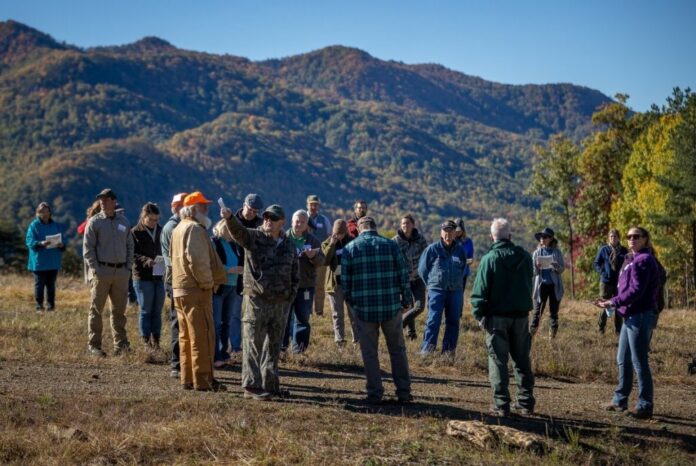For Jennifer Gagnon, the best part of leading Forestry and Wildlife Tours is the conversations that take place as she visits a forested property, tours a barrel cooperage, or drives a 12-passanger van to the next destination on the tour.
“The best part of these tours is the people sharing their stories,” said Gagnon, coordinator of the Virginia Forest Landowner Education Program. “The tours provide opportunities for people who own tracts of land to talk and learn from each other. They get the chance to make connections with other landowners and natural resource professionals.”
Connecting forest landowners with the research knowledge at Virginia Tech is a key aim of Virginia Cooperative Extension and the Virginia Forest Landowner Education Program.
“Private individuals and families own over two-thirds of all our forests in Virginia,” said Gagnon, a member of the College of Natural Resources and Environment’s Department of Forest Resources and Environmental Conservation. “We want the people who own those forests to have the information they need to take care of them, to make sure that they’re healthy and productive, so that we can all benefit from them, both environmentally and economically.”
“The district foresters take the lead on planning our tours,” said Gagnon, who has coordinated the tours since 2006. “They put the hard work into reaching out to landowners or businesses and asking for permission to access land or tour a factory or a timber harvest. Then they’ll do a dry run of the route to check which sites can be accessed easily by a tour bus or van.”
This past year’s tours reflect the range of experiences and knowledge offered to participants. In Bland County, landowners visited a 500-acre Tree Farm, a family firewood business, and a timber harvesting operation before attending a presentation on the benefits of prescribed burning in the Appalachian forests. In Mecklenburg County, participants visited a Wildlife Management Area and then toured Virginia’s largest human-made lake to better understand the dynamics between human and ecosystem processes.
Access has always been a priority: The tours are planned to minimize strenuous walks, and scholarships are available for area K-12 teachers interested in learning about forestry and wildlife.
One way that Gagnon plans to make tours more accessible for 2024 involves the use of technology. “This year, we’re excited to introduce portable headsets for use on mill tours,” said Gagnon. “Typically, our participants are broken into groups with a leader, and it can sometimes be difficult to hear that’s being said inside a noisy facility. That should no longer be a problem.”
Gagnon said that the Fall Forestry and Wildlife Field Tours are a collaborative effort that rely significantly on the contributions of partners, including federal and state agencies, the forest industry, and private contractors.
“We couldn’t provide this service without the contributions of the Virginia Department of Forestry and the Virginia Department of Wildlife Resources, as well as other partners,” she said. “We’re tasked with providing educational programming to the entire state, and we really rely on the folks that work with landowners every day to keep us updated on what information and services we can provide.”

In addition to the fall tours, Gagnon and two of the district forestry Extension agents lead winter Woods and Wildlife Conferences, where residents and landowners participate in presentations on subjects as varied as growing wild ginseng, managing invasive species, considering solar energy options, and discussing silvopasture strategies that allow livestock, trees, and vegetation to share a landscape. The group also leads Generation NEXT workshops on legacy planning for forest properties, workshops on best practices for prescribed burning, online courses and weekend retreats on forest management, and even a SHARP Logger program that details how to harvest trees safely.
For Gagnon – who boasts that she can now drive a 12-passanger van better than her own car – the highlight of the tours is having the chance to provide connections between forest landowners and the resources that drive Virginia’s third-largest industry.
“Our forest landowners spend 25 years of their lives growing a pine tree, or maybe 75 years growing a hardwood, and it’s always exciting to see them come into a place that is using that resource so they know that their work is contributing to the economics of the state.”
The 2024 schedule for upcoming Fall Forestry and Wildlife Field Tours will be available this summer. Sign up for a tour and read about all of the services and programs offered.

